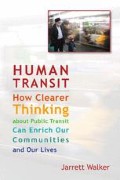Abstract
As we’ve explored the geometry of transit and the choices it presents, we’ve seen that the quality and cost-effectiveness of transit is determined by the layout of the community it serves. We’ve seen that the ease of walking to transit stops is a fact about the community and where you are in it, not a fact about the transit system. We’ve noticed that grids are an especially efficient shape for a transit network, so that’s obviously an advantage for gridded cities, like Los Angeles and Chicago, that fit that form easily. We’ve also noticed that chokepoints—like mountain passes and water barriers of many cities—offer transit a potential advantage. We’ve seen how density, both residential and commercial, is a powerful driver of transit outcomes, but that the design of the local street network matters too. High-quality and cost-effective transit implies certain geometric patterns. To the extent that those patterns work with the design of your community, you can have transit that’s both high-quality and cost-effective. To the extent that they don’t, you can’t.
Notes
- 1.
Of course, a rapid transit station is ideal only to the extent that the rapid transit network is complete. A fragmentary rapid transit system, such as you’ll find in many North American cities, will be less useful, except to the extent that it’s integrated with other transit alternatives—and nontransit alternatives such as taxis and carsharing—that allow you to get to wherever you may be going.
- 2.
And, as we saw in chapter 13, the ability of local transit services to converge on the station and make connections there.
Author information
Authors and Affiliations
Rights and permissions
Copyright information
© 2012 Jarrett Walker
About this chapter
Cite this chapter
Walker, J. (2012). Be on the Way! Transit Implications of Location Choice. In: Human Transit. Island Press, Washington, DC. https://doi.org/10.5822/978-1-61091-174-0_14
Download citation
DOI: https://doi.org/10.5822/978-1-61091-174-0_14
Publisher Name: Island Press, Washington, DC
Online ISBN: 978-1-61091-174-0
eBook Packages: Earth and Environmental ScienceEarth and Environmental Science (R0)


